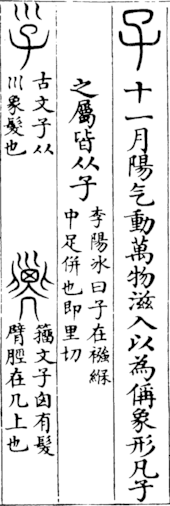Shizhoupian

The Shizhoupian (Chinese: 史籀篇; pinyin: Shǐzhòupiān) was an early dictionary of Chinese characters written in the Great Seal script. The work was traditionally dated to the reign of King Xuan of Zhou (827–782 BCE), but many modern scholars assign it to the State of Qin in the Warring States period. It is now known only through fragments.
The Zhòuwén (籀文) are 220 or so examples of ancient characters from the Shizhoupian quoted in the Han dynasty character dictionary Shuowen Jiezi.[2] The zhòuwén characters have been described as generally symmetrical and balanced, and are on average (although not always) more complex than the later seal characters.[3] They contain many swirls and circles in place of later squared or rectilinear forms.
According to the postface of the Shuowen Jiezi and the "Treatise on Literature" chapter of the Book of Han, the work was written during the reign of the late Western Zhou king Xuan by Shǐ Zhòu (史籀 "Historian Zhou"), and consisted of 15 chapters (篇 piān).[4]
Wang Guowei disputed this account in his commentary on the Shizhoupian, arguing that the structure and style of the characters did not match inscriptions from the period.[5] Wang also questioned the traditional interpretation of zhòu (籀) as the historian's name, pointing out that in ancient times, according to the Shuowen, it had the same meaning as 讀 dú ("to study and understand the meaning of books; to read"). According to this view, the title of the book was likely taken from the first sentence of the text (as is often done when assigning names to untitled ancient texts like those on bronzes), which presumably contained "the historian studies...".[3][6][7]
Tang Lan identified Shǐ Zhoù (Historian Zhòu) with Shǐ Liú (史留 "Historian Liú"), a name written with a similar character in the Book of Han chapter on "Notable Persons Past and Present" covering the Spring and Autumn and Warring States periods.[3] A Historian Liú from the correct period is mentioned on an ancient dǐng tripodal cauldron in the collection of the Shanghai Museum.[8]
References
Sources
- Chén, Zhāoróng 陳昭容 (2003), 秦系文字研究 ﹕从漢字史的角度考察 [Research on the Qin Lineage of Writing: An Examination from the Perspective of the History of Chinese Writing], Academia Sinica, Institute of History and Philology Monograph, ISBN 957-671-995-X.
- Galambos, Imre (2006), Orthography of early Chinese writing: evidence from newly excavated manuscripts, Budapest monographs in East Asian Studies, 1, Department of East Asian Studies, Eötvös Loránd University, ISBN 978-963-463-811-7.
- Qiu, Xigui (2000), Chinese writing, trans. by Gilbert L. Mattos and Jerry Norman, Berkeley: Society for the Study of Early China and The Institute of East Asian Studies, University of California, ISBN 978-1-55729-071-7. (English translation of Wénzìxué Gàiyào 文字學概要, Shangwu, 1988.)
- 漢語大字典. Hànyǔ Dà Zìdiǎn, 1992. 湖北辭書出版社和四川辭書出版社 Húběi Císhū Chūbǎnshè and Sìchuān Císhū Chūbǎnshè; Taiwanese reprint (traditional characters) from 建宏出版社 Jiànhóng Publ. in Taipei. ISBN 957-813-478-9.